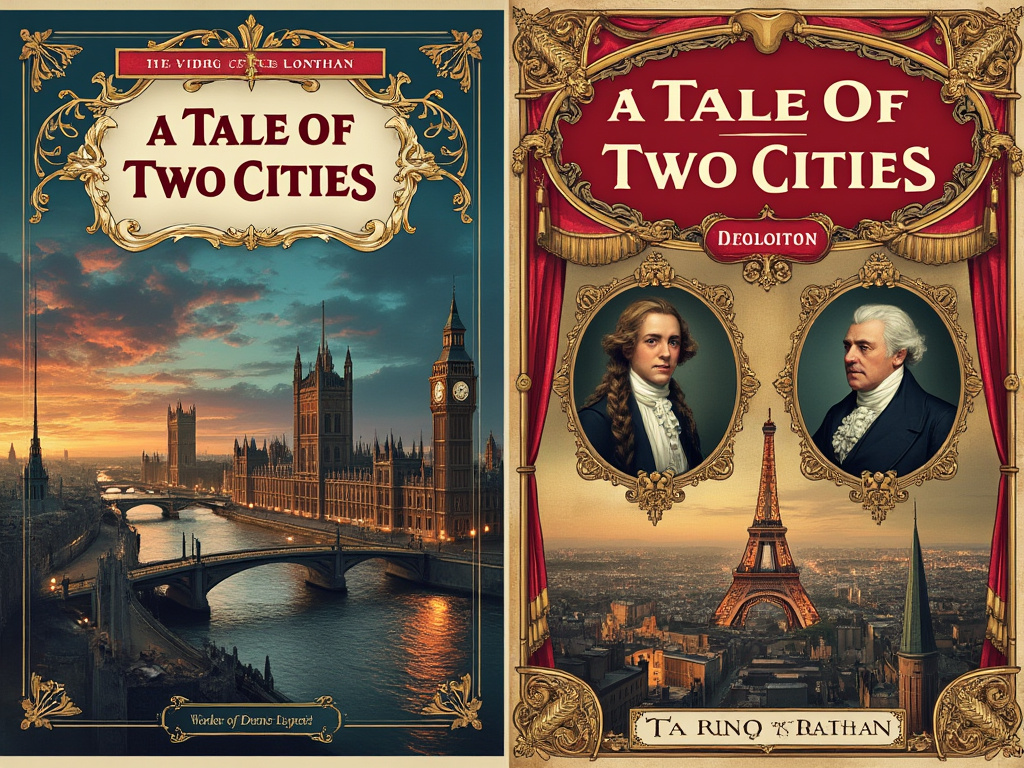Exploring Duality and Redemption
“A Tale of Two Cities” by Charles Dickens is a masterful work of historical fiction, set against the backdrop of the French Revolution. This novel, first published in 1859, remains one of Dickens’ most celebrated works, exploring themes of sacrifice, redemption, and the stark contrasts between wealth and poverty, love and hate, and life and death. As you journey through “A Tale of Two Cities,” you’ll be drawn into the lives of its unforgettable characters, who navigate the turbulent times of late 18th-century London and Paris.

From its iconic opening line, “It was the best of times, it was the worst of times,” “A Tale of Two Cities” sets the stage for a dramatic exploration of two cities—London and Paris. “One of the most tumultuous periods in history sets these cities against each other.” The novel follows the stories of several characters, whose lives intertwine in unexpected ways. At the center of the narrative is Charles Darnay, a French aristocrat who renounces his family’s oppressive ways. Also central is Sydney Carton, a dissolute English lawyer with a noble heart. Love, loyalty, and revolution shape the lives of these two men, who bear an uncanny physical resemblance to each other.
“A Tale of Two Cities” is not only a tale of personal sacrifice but also a commentary on the broader social and political issues of the time. Dickens vividly depicts the squalor and injustice that fueled the flames of revolution in France, contrasting it with the relative stability, yet underlying tension, in England. Through the dual settings of London and Paris, Dickens explores the idea of duality—two cities, two nations, and two very different societies. This theme is central to the novel, as Dickens juxtaposes the opulence of the aristocracy with the suffering of the poor, and the revolutionary fervor with the fear and complacency of those in power.
Character Development and Redemption in “A Tale of Two Cities”
The character development in “A Tale of Two Cities” is one of its strongest aspects. Dickens creates a rich tapestry of characters, each with their own distinct personality and moral dilemmas. Charles Darnay, despite his noble birth, is a compassionate and honorable man. He is willing to risk his life to stand up for what is right. In contrast, Sydney Carton initially portrays himself as a cynical and self-destructive individual. However, as the story unfolds, the story reveals his true character. Carton’s ultimate act of self-sacrifice—taking Darnay’s place at the guillotine—is one of the most poignant moments in literature. It epitomizes the theme of redemption that runs throughout the novel.
Lucie Manette, the daughter of Dr. Alexandre Manette, is another key character in the novel. She is the embodiment of compassion and love, serving as the emotional center of the story. Her unwavering devotion to her father and her ability to bring out the best in those around her. This makes her a symbol of hope amidst the chaos of the revolution. Dr. Manette’s story is also central to the novel. His traumatic experiences in the Bastille reflect the brutality and dehumanization of the period.
Symbolism and Themes in “A Tale of Two Cities”
The title, “A Tale of Two Cities,” refers to the cities of London and Paris. It also highlights the dichotomies Dickens explores throughout the novel. The book is a tale of contrasts: love and hate, sacrifice and selfishness, resurrection and death. These dualities are embodied in the characters and the cities they inhabit, making the novel a complex and layered narrative.
One of the most striking features of “A Tale of Two Cities” is Dickens’ use of vivid imagery and symbolism. The storming of the Bastille and the relentless march of revolutionaries through Paris are powerful scenes. The guillotine, a central symbol, represents both the horror of the revolution and the idea of inescapable fate. Dickens also uses the motif of resurrection, particularly in the character of Dr. Manette, who is “recalled to life” after his long imprisonment. Sydney Carton’s ultimate sacrifice brings about his spiritual rebirth.
“A Tale of Two Cities” has been praised for its exploration of timeless themes. The novel’s examination of social justice, the consequences of oppression, and the power of love and sacrifice continues to resonate with readers. Dickens’ portrayal of the French Revolution serves as a reminder of the dangers of extremism. It also highlights the importance of compassion and humanity in times of turmoil.
For those new to Dickens or classic literature, “A Tale of Two Cities” offers a perfect introduction. Its fast-paced plot, memorable characters, and richly detailed settings make it an engaging read. Its exploration of universal themes ensures its enduring relevance, making it a compelling story that appeals to readers of all ages.
You might be interested in reading The Adventures of Ferdinand Count Fathom by T. Smollett as well.
More Book Reviews on NFTBOOKS platform is HERE.







